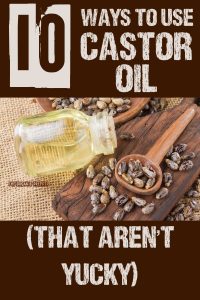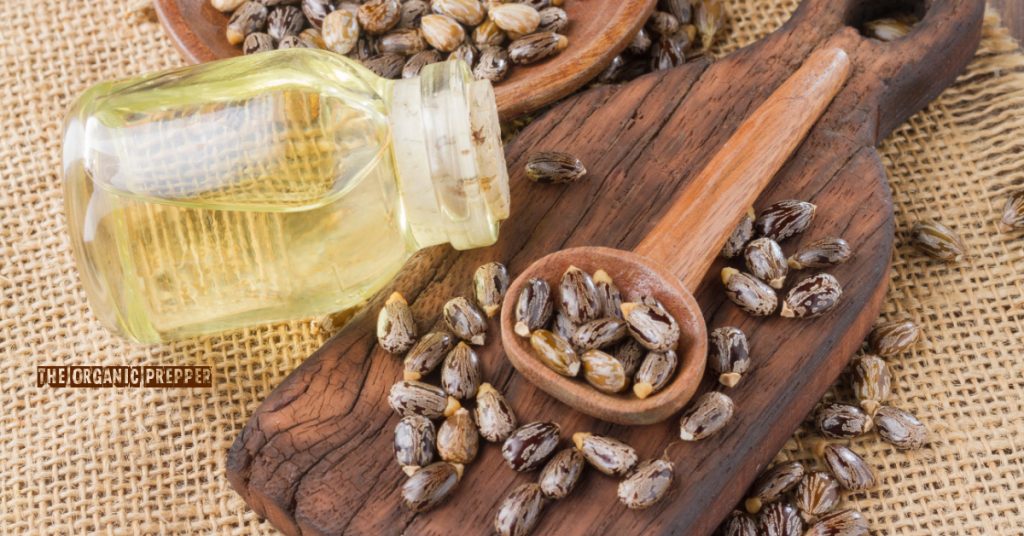If you're new here, you may want to subscribe to my RSS feed. Thanks for visiting!
By the author of Be Ready for Anything and Bloom Where You’re Planted online course
Did your parents ever insist you take castor oil as a kid? That is some foul-tasting stuff. Luckily for children today, that particular trend seems to have gone away.
But the last generation was on to something – castor oil has many uses, most of which do not require consumption.
What is castor oil?
Castor oil is made from the seeds of the castor plant. (Ricinus communis) It is an ingredient in many modern drugs, including:
- Miconazole, an antifungal agent.
- Paclitaxel, a mitotic inhibitor used in cancer chemotherapy.
- Sandimmune (cyclosporine injection, USP), an immunosuppressant drug widely used in connection with organ transplant to reduce the activity of the patient’s immune system.
- Nelfinavir mesylate, an HIV protease inhibitor.
- Tacrolimus, an immunosuppressive drug (contains HCO-60, polyoxyl 60 hydrogenated castor oil);
- Xenaderm ointment, a topical treatment for skin ulcers, is a combination of Balsam of Peru, castor oil, and trypsin.
- Aci-Jel (composed of ricinoleic acid from castor oil, with acetic acid and oxyquinoline) is used to maintain the acidity of the vagina.
- Optive Plus (carboxymethylcellulose, castor oil) and Refresh Ultra (glycerine, castor oil), are artificial tears to treat dry eye.
- Castor oil is also one of the components of Vishnevsky liniment. (source)

It’s interesting to note that the plant and beans that it comes from are also used in the creation of ricin, one of the most deadly plant toxins in existence.
Here are a few alternative uses for castor oil.
Here are some ways that odious-tasting stuff has been used throughout history… and you don’t even have to consume it! These are all historical uses and not medical recommendations, of course.
- To lubricate kitchen tools. Since castor oil can be ingested, it’s an ideal lubricant for anything that comes into contact with food, like kitchen scissors, knives and knife sharpeners. You can also use it to lubricate other things around the home with no worries about kid or pets because it is non-toxic.
- For topical pain relief. Mix castor oil with a little turmeric or cayenne pepper and rub into achy joints for pain relief.
- On fungal diseases. If medical attention is not available, try castor oil for its anti-fungal properties. It could relieve the symptoms of common infections like ringworm, jock itch (tinea cruris), and athlete’s foot. Simply warm the oil, apply to the affected area before bedtime, and leave it on overnight. Repeat for a week or until the infection has disappeared completely.
- To apply directly to your skin to improve elasticity. Old-fashioned midwives still recommend that pregnant women massage their growing belly to help avoid stretch marks. (Mine did- it worked for me!)
- To aid hair growth. Apply directly to the scalp or sparse brows and lashes.
- To apply to corns and calluses. Massaging the oil into corns and calluses over a period of a couple of weeks will soften the skin and help the lumps disappear.
- To treat split ends. The appearance of split ends can be improved by smoothing castor oil onto them. Warm between your palms and smooth on, leave for a couple of hours, and wash your hair as usual.
- To apply to minor skin irritations. Scratches and breakouts can benefit from dabbing on a small amount of castor oil. This takes away itching and irritation.
- To treat external hemorrhoids. Soak a cotton ball in castor oil, then leave it on the affected area for 15 minutes.
- To get rid of moles. Moles hate castor oil. Mix half a cup with a couple of gallons of water and pour directly onto the molehills. It’s non-toxic and won’t kill the moles or the grass, but it will certainly encourage the annoying critters to move elsewhere.
I was told when I was pregnant that drinking castor oil could induce labor naturally. I dutifully chugged down a small bottle of the nasty stuff when I was two weeks overdue, hoping to evict my little tenant, who had stayed too long. Spoiler: it didn’t work and only gave me a bad case of diarrhea.
Bonus: Internal Use
I know – YUCK. But here’s why our grandparents swore by the stuff.
Castor oil can be used as a laxative. When taken orally, ricinoleic acid gets released in the intestine and then it starts functioning as a laxative. The heat created by castor oil initiates action by helping the process of digestion and cleansing the system by helping in proper bowel movement. Luckily, this comes in capsule form, so you don’t have to choke it down.
Look at all those uses, and only once did I suggest you consume it! If you have any more ways to use castor oil, please share them in the comments box below.
Castor Oil: Order it here.
Have you ever used castor oil? Did your grandparents swear by it? Do you have any uses to recommend that weren’t mentioned here? Let’s discuss it in the comments section.
About Daisy
Daisy Luther is a coffee-swigging, adventure-seeking, globe-trotting blogger. She is the founder and publisher of three websites. 1) The Organic Prepper, which is about current events, preparedness, self-reliance, and the pursuit of liberty; 2) The Frugalite, a website with thrifty tips and solutions to help people get a handle on their personal finances without feeling deprived; and 3) PreppersDailyNews.com, an aggregate site where you can find links to all the most important news for those who wish to be prepared. Her work is widely republished across alternative media and she has appeared in many interviews.
Daisy is the best-selling author of 5 traditionally published books, 12 self-published books, and runs a small digital publishing company with PDF guides, printables, and courses at SelfRelianceand Survival.com You can find her on Facebook, Pinterest, Gab, MeWe, Parler, Instagram, and Twitter.
















Yep, I remember it. (I am old, lol) We had a 6- or 8-ounce bottle of it, I believe. I do not remember having to take it very often and when that one bottle was empty it was not replaced.
My father pretty much had to hog-tie my two younger brothers to get them to take a dose. It came real close with me during one extended case where I had to take it once a day for five or six days. I do not remember why I had to take it, just that I dreaded it each time it was time to take it that day.
There are at least a couple more uses I have heard about but never done myself. One is as a general lubricant on farms with quite a bit of equipment. It was also sometimes used early on as a motor oil. Before all the changes in fuels came about and a plain oil like castor oil was not able to handle the new ingredients or it interacted with some of them and actually could damage an engine.
It was also used as the primary lubricant in the early days of aviation in the common rotary engines. The rotary engine with the pistons arranged in a circle, not the Mazda rotary engine.
It is sometimes used to produce a biodiesel often used in colder climates because it has properties that just work better than standard formulations.
I remember losing an argument when I was in high school chemistry class about castor oil uses to make quite a few things one might not think about. Fragrances and perfumes, for one. I simply could not fathom castor oil being in any fragrance. Lithium grease for another. Those all require extensive processing so are not really applicable to prepper use.
Now that this has triggered a couple of specific memories I plan to research using castor oil to make biodiesel, though.
Just my opinion.
I have used it when I got some chemicals in my eyes. My eyes are fine. Also used it on my skin when the same chemical was burning my skin.
Was it really castor oil or cod-liver oil your family gave you? I thought castor oil should never be taken internally. We love love love castor oil and use it liberally on many skin conditions. Thank you for more tips!
Castor Oil is one of the most penetrating, healing oils that we can use on our bodies. Soaked cotton cloth used as a poultice, and worn overnight, will help to reduce swelling; worn as a poultice on your tummy, it will help you to get rid of constipation – in a much more tender way than consuming it as a laxative. Just put some plastic food wrapping between the oil and your clothing – only Persil Stain Fighter will take it out of your clothes. Used as a poultice it will penetrate and help to heal torn, bruised and aching tissue.
I don’t think we have discovered all the ways yet that Castor Oil can help us.
Blessings,
Old Duffer
I’m not going there. I won’t use castor oil anywhere near the body. We had a castor bean plant in the back yard when I was a teenager (previous owner had planted it). That’s when I learned the plant is poisonous. If a product contains castor oil, I won’t buy it.
There are many plants that contain edible and/or healing ingredients but you have to harvest them at the right time and correctly. Some parts of a plant are poisonous or hurtful to the body and other parts are incredibly beneficial. Point in case: Aloe Vera leaves.
Read “The Oil That Heals” . This is a miracle oil. Liver packs, infections in cuts and glands with compresses, softening, acne, it has healing properties
I too swear about castor oil ,used it to remove splinters from hands and feet ,make joints more flexible and yes as an elimination helper too.
Good luck finding it locally right now… it’s on social media. I manage a health food store and can’t order enough to satisfy demand – only one of my vendors has it in stock and it’s gone as soon as I get it in.
Check Wal Mart or local grocery store.
Castor oil is used by some as a laxitive, has a mild taste or mix it with a sports drink or juice. One-2 teaspoons for most.
We use it to repel racoons once there is evidence that they have tried to dig under the greenhouse… where the catfood is. It works.